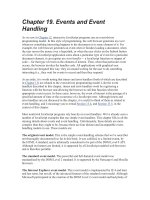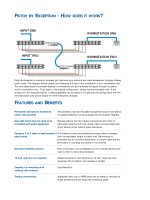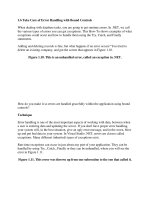Exception Handling
Bạn đang xem bản rút gọn của tài liệu. Xem và tải ngay bản đầy đủ của tài liệu tại đây (1.22 MB, 55 trang )
Copyright © 2007 Pearson Education, Inc. Publishing as Pearson Addison-Wesley
Chapter 16
Exception Handling
Slide 16- 3
Copyright © 2007 Pearson Education, Inc. Publishing as Pearson Addison-Wesley
Overview
16.1 Exception-Handling Basics
16.2 Programming Techniques for
Exception Handling
Copyright © 2007 Pearson Education, Inc. Publishing as Pearson Addison-Wesley
16.1
Exception-Handling Basics
Slide 16- 5
Copyright © 2007 Pearson Education, Inc. Publishing as Pearson Addison-Wesley
Exception Handling Basics
It is often easier to write a program by first
assuming that nothing incorrect will happen
Once it works correctly for the expected
cases, add code to handle the exceptional cases
Exception handling is commonly used to handle
error situations
Once an error is handled, it is no longer an
error
Slide 16- 6
Copyright © 2007 Pearson Education, Inc. Publishing as Pearson Addison-Wesley
Functions and
Exception Handling
A common use of exception handling:
Functions with a special case that is handled in
different ways depending on how the function
is used
If the function is used in different programs,
each program may require a different action
when the special case occurs
Slide 16- 7
Copyright © 2007 Pearson Education, Inc. Publishing as Pearson Addison-Wesley
Exception Handling Mechanism
In C++, exception handling proceeds by:
Some library software or your code signals that
something unusual has happened
This is called throwing an exception
At some other place in your program you place
the code that deals with the exceptional case
This is called handling the exception
Slide 16- 8
Copyright © 2007 Pearson Education, Inc. Publishing as Pearson Addison-Wesley
A Toy Example
Exception handling is meant to be used sparingly
in situations that are generally not reasonable
introductory examples
For this example:
Suppose milk is so important that we almost
never run out
We still would like our program to handle the
situation of running out of milk
Slide 16- 9
Copyright © 2007 Pearson Education, Inc. Publishing as Pearson Addison-Wesley
The Milk Example (cont.)
Code to handle the normal situations involving
milk, might be:
cout << "Enter number of donuts:\n";
cin >> donuts;
cout << "Enter number of glasses of milk:\n";
cin >> milk;
dpg = donuts /static_cast<double>(milk);
cout << donuts << " donuts.\n"
<< milk << " glasses of milk.\n"
<< "You have " << dpg
<< " donuts per glass of milk.\n";
Slide 16- 10
Copyright © 2007 Pearson Education, Inc. Publishing as Pearson Addison-Wesley
If there is no milk, the code on the previous slide
results in a division by zero
We could add a test case for this situation
shows the program with the
test case
shows the program
rewritten using an exception
Display 16.1
Display 16.2 (1-2)
The No Milk Problem
Slide 16- 11
Copyright © 2007 Pearson Education, Inc. Publishing as Pearson Addison-Wesley
The try Block
The program of Display 16.2 replaces the test
case in the if-else statement with
if(milk <= 0)
throw donuts;
This code is found in the try block
try
{
Some_Code
}
which encloses the code to handle the normal situations
Slide 16- 12
Copyright © 2007 Pearson Education, Inc. Publishing as Pearson Addison-Wesley
The Try Block Outline
The try block encloses code that you want to
"try" but that could cause a problem
The basic outline of a try block is:
try
{
Code_To_Try
Possibly_Throw_An_Exception
More_Code
}
Slide 16- 13
Copyright © 2007 Pearson Education, Inc. Publishing as Pearson Addison-Wesley
The Exception
To throw an exception, a throw-statement is
used to throw a value
In the milk example:
throw donuts;
throws an integer value.
The value thrown is sometimes called an
exception
You can throw a value of any type
Slide 16- 14
Copyright © 2007 Pearson Education, Inc. Publishing as Pearson Addison-Wesley
The catch-block
Something that is thrown goes from one place
to another
In C++ throw causes the flow of control to go
to another place
When an exception is thrown, the try block
stops executing and the catch-block begins
execution
This is catching or handling the exception
Slide 16- 15
Copyright © 2007 Pearson Education, Inc. Publishing as Pearson Addison-Wesley
The Milk catch-block
The catch-block from the milk example looks
like, but is not, a function definition with a
parameter:
catch(int e)
{
cout << e << donuts, and no milk!\n"
<< "Go buy some milk.\n";
}
If no exception is thrown, the catch-block is
ignored during program execution
Slide 16- 16
Copyright © 2007 Pearson Education, Inc. Publishing as Pearson Addison-Wesley
The catch-block Parameter
The catch-block parameter, (recall that the
catch-block is not a function) does two things:
The type of the catch-block parameter
identifies the kind of value the catch-block can
catch
The catch-block parameter provides a name
for the value caught so you can write code
using the value that is caught
Slide 16- 17
Copyright © 2007 Pearson Education, Inc. Publishing as Pearson Addison-Wesley
try-blocks and if-else
try-blocks are very similar to if-else statements
If everything is normal, the entire try-block is
executed
else, if an exception is thrown, the catch-block
is executed
A big difference between try-blocks and if-else
statements is the try-block's ability to send a
message to one of its branches
Slide 16- 18
Copyright © 2007 Pearson Education, Inc. Publishing as Pearson Addison-Wesley
try-throw-catch Review
This is the basic mechanism for throwing and
catching exceptions
The try-block includes a throw-statement
If an exception is thrown, the try-block ends
and the catch-block is executed
If no exception is thrown, then after the try-
block is completed, execution continues with
the code following the catch-block(s)
Slide 16- 19
Copyright © 2007 Pearson Education, Inc. Publishing as Pearson Addison-Wesley
Defining an Exception Class
Because a throw-statement can throw a value of
any type, it is common to define a class whose
objects can carry the kind of information you
want thrown to the catch-block
A more important reason for a specialized
exception class is so you can have a different
type to identify each possible kind of exceptional
situation
Slide 16- 20
Copyright © 2007 Pearson Education, Inc. Publishing as Pearson Addison-Wesley
An exception class is just a class that happens to
be used as an exception class
An example of a program with a programmer
defined exception class is in
Display 16.3 (1-2)
The Exception Class
Slide 16- 21
Copyright © 2007 Pearson Education, Inc. Publishing as Pearson Addison-Wesley
Throwing a Class Type
The program in Display 16.3 uses the
throw-statement
throw NoMilk(donuts);
This invokes a constructor for the class NoMilk
The constructor takes a single argument of
type int
The NoMilk object is what is thrown
The catch-block then uses the statement
e.get_donuts( )
to retrieve the number of donuts
Slide 16- 22
Copyright © 2007 Pearson Education, Inc. Publishing as Pearson Addison-Wesley
A try-block can throw any number of exceptions
of different types
In any one execution, only one exception can
be thrown
Each catch-block can catch only one exception
Multiple catch-blocks may be used
A parameter is not required in a catch-block
A sample program with two catch-blocks is
found in
Display 16.4 (1-3)
Multiple Throws and Catches
Slide 16- 23
Copyright © 2007 Pearson Education, Inc. Publishing as Pearson Addison-Wesley
A Default catch-block
When catching multiple exceptions, write the
catch-blocks for the most specific exceptions
first
Catch-blocks are tried in order and the first one
matching the type of exception is executed
A default (and last) catch-block to catch any
exception can be made using "…" as the
catch-block parameter
catch(…)
{ <the catch block code> }
Slide 16- 24
Copyright © 2007 Pearson Education, Inc. Publishing as Pearson Addison-Wesley
Exception Class DivideByZero
In Display 16.4, exception class DivideByZero
was defined as
class DivideByZero
{ } ;
This class has no member variables or member
functions
This is a trivial exception class
DivideByZero is used simply to activate the appropriate
catch-block
There is nothing to do with the catch-block parameter so
it can be omitted as shown in Display 16.4
Slide 16- 25
Copyright © 2007 Pearson Education, Inc. Publishing as Pearson Addison-Wesley
Exceptions In Functions
In some cases, an exception generated in a
function is not handled in the function
It might be that some programs should end,
while others might do something else, so within
the function you might not know how to handle
the exception
In this case, the program places the function
invocation in a try block and catches the
exception in a following catch-block









